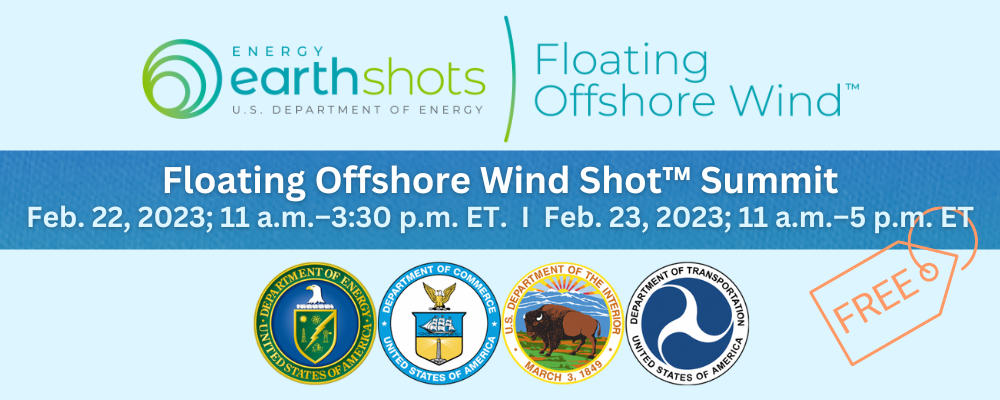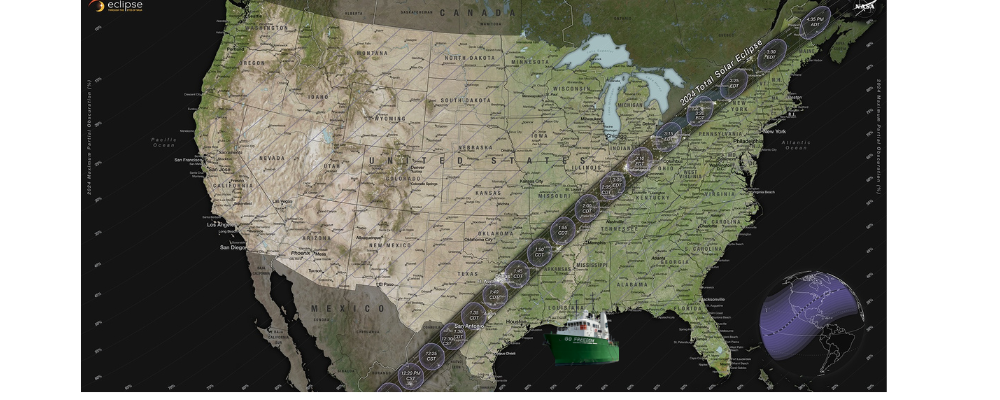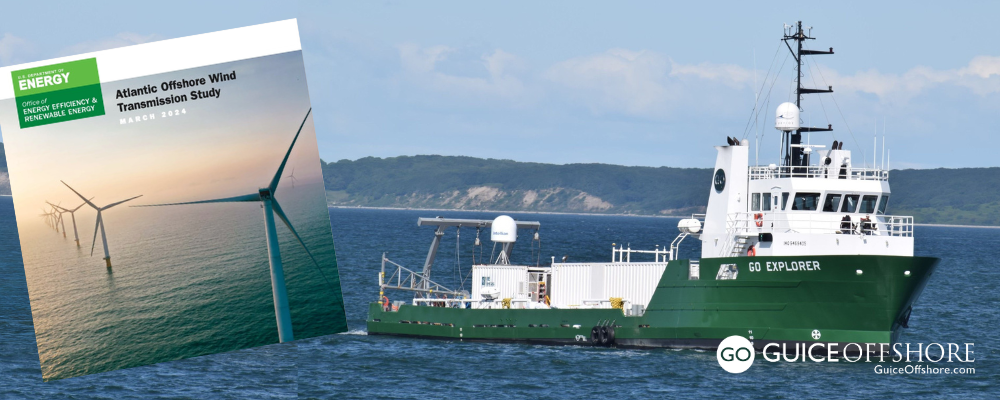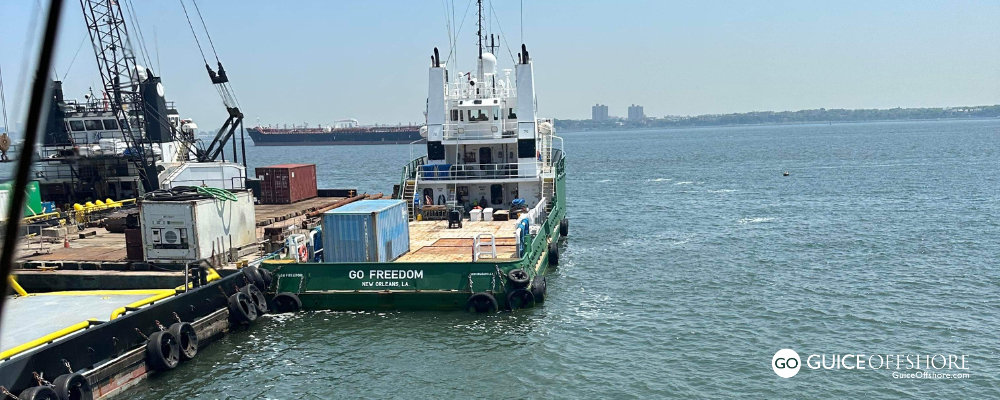Video Above: The U.S. Department of Energy and the Bureau of Ocean Energy Management hosted a webinar in Fall 2022 on their ambitious initiatives to position the U.S. to lead the world on floating offshore wind design, development, manufacturing, and deployment. Download the slides from this webinar. (Credit: U.S. Department of Energy)
On Feb. 22 and 23, 2023, the Departments of Energy, the Interior, Commerce, and Transportation will virtually convene offshore wind energy stakeholders to discuss the Floating Offshore Wind Shot™—an ambitious initiative to cut the cost of floating offshore wind energy by over 70 percent by 2035.
Register HERE for the Floating Offshore Wind Shot Summit.
To view the agenda, click HERE.
The Floating Offshore Wind Shot is an initiative to help usher in a clean energy future by driving U.S. leadership in floating offshore wind design, development, and manufacturing.
It is part of the U.S. Department of Energy’s Energy Earthshots Initiative to tackle key remaining technical challenges to reaching U.S. climate goals while creating jobs and economic opportunities for U.S. communities.
Floating offshore wind is key to transitioning dense population centers to clean energy, and would also mean thousands of jobs in wind manufacturing, installation, and operations.
The Floating Offshore Wind Energy Shot seeks to reduce the cost of floating offshore wind energy by at least 70 percent, to $45 per megawatt-hour by 2035 for deep sites far from shore.
Deep-water areas that require floating platforms are home to two-thirds of America’s offshore wind energy potential—a clean energy resource that is key to meeting the nation’s climate goals. Capturing this vast potential can power millions of American homes and businesses and bring significant economic benefits but will require unprecedented collaboration between federal and state governments, local communities, tribes, and the private sector. This interagency summit will bring together a broad range of parties to affirm a shared vision of wide-scale floating offshore wind energy deployment and dive into the technical, social, equity, and environmental challenges and opportunities it presents.
About two-thirds of U.S. offshore wind energy potential exists over waters too deep for today’s fixed-bottom wind turbine foundations secured directly to the sea floor, and instead require floating platforms. These structures will be among the largest humankind has ever constructed. Achieving the Floating Offshore Wind Shot goals will require an all-out effort to develop a robust domestic supply chain, reduce technology costs, and plan and build out needed transmission.
The purpose of the summit is to share information regarding the Floating Offshore Wind Shot goals, the framework and plans for future work, currently available resources, and opportunities for future engagement. Day 1 will focus on remarks from national leaders on floating offshore wind energy, an overview of the Shot, and national floating offshore wind energy deployment efforts and considerations. Day 2 will focus on state leader, industry, and stakeholder perspectives on floating offshore wind energy and describe the plans and priorities for future Shot efforts.
This interagency Floating Offshore Wind Energy Shot Summit will bring together a broad range of parties to affirm a shared vision of wide-scale floating offshore wind energy deployment and dive into the technical, social, and environmental challenges and opportunities it presents.
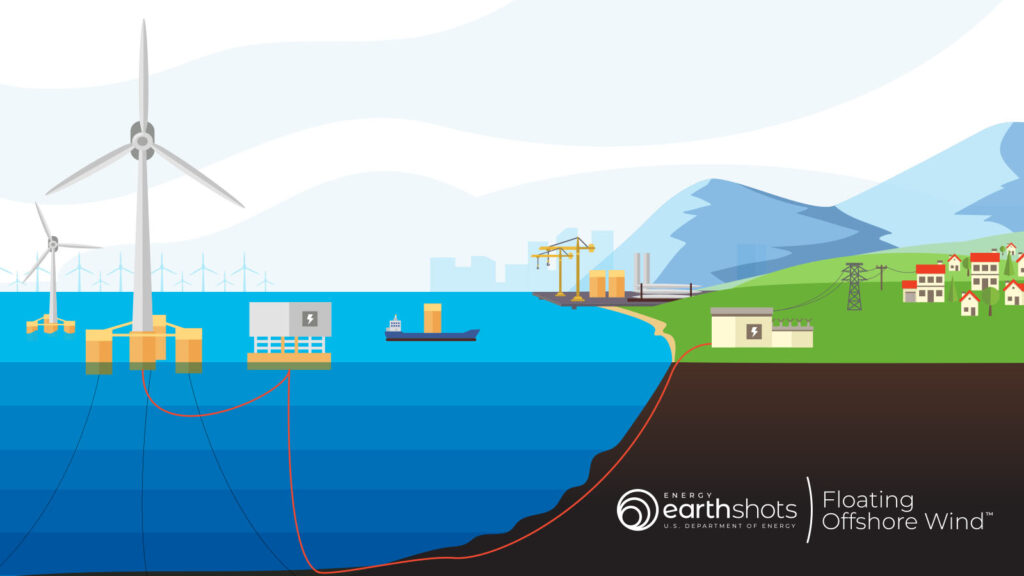 Floating Offshore Wind Fact Sheet and Background
Floating Offshore Wind Fact Sheet and Background
In September 2022, the federal government launched coordinated actions to develop new floating offshore wind platforms, an emerging clean energy technology that will help the United States lead on offshore wind as part of America’s overall economic and clean energy agenda. These actions will create good-paying jobs, lower energy costs for families, and strengthen U.S. energy security. Since 2021, the American offshore wind industry has been jumpstarted and made the United States into a magnet for clean energy investments with the bold goal of deploying 30 gigawatts (GW) of offshore wind by 2030, enough to power 10 million homes with clean energy, support 77,000 jobs, and spur private investment up and down the supply chain.
Conventional offshore wind turbines can be secured directly to the sea floor in shallow waters near the East Coast and the Gulf of Mexico. However, deep-water areas that require floating platforms are home to two-thirds of America’s offshore wind energy potential, including along the West Coast and in the Gulf of Maine. The new governmental actions will capture this vast potential to power millions of homes and businesses, grow new manufacturing and maritime industries at home, and tackle the climate crisis.
They also will position the U.S. to lead the world on floating offshore wind technology. Globally, only 0.1 GW of floating offshore wind has been deployed to date, compared with over 50 GW of fixed-bottom offshore wind. America will seize this opportunity to be a frontrunner on floating offshore wind technologies, as part of the federal government’s plan for a clean energy economy built by American workers.
On September 22, 2o22, White House National Climate Advisor Gina McCarthy, Energy Secretary Jennifer Granholm, and Interior Secretary Deb Haaland joined state officials to announce:
- New Floating Offshore Wind ShotTM to Lower Costs by 70 Percent: Through the Energy EarthshotTM program, the Administration will create a new Floating Offshore Wind Shot to accelerate breakthroughs across engineering, manufacturing, and other innovation areas. The Floating Offshore Wind Shot will aim to reduce the costs of floating technologies by more than 70% by 2035, to $45 per megawatt-hour.
- New Goal to Reach 15 GW by 2035: The Administration will advance lease areas in deep waters in order to deploy 15 GW of floating offshore wind capacity by 2035—building on the President’s existing goal of deploying 30 GW of offshore wind by 2030, which will be largely met using fixed-bottom technology.
- Research & Development Investments: To support these goals, this week the Administration launched a new prize competition for floating offshore wind platform technologies; initiatives funded by the Bipartisan Infrastructure Law to develop modeling tools for project design and to analyze port needs; and other funding for research, development, and demonstration efforts.
These new goals, initiatives, and investments focus on floating technologies and build on the Administration’s all-of-government approach to developing offshore wind while advancing environmental justice, protecting biodiversity, and promoting ocean co-use. The Inflation Reduction Act provides clean energy tax credits that will further accelerate this new American industry and a thriving domestic supply chain, with support for Made in America wind turbine blades, fixed-bottom and floating platforms, installation vessels, and more.
NEW FLOATING OFFSHORE WIND ENERGY EARTHSHOT
Secretaries Granholm and Haaland announced the Floating Offshore Wind ShotTM, a new initiative to grow clean energy capacity and drive U.S. leadership in floating offshore wind design, development, and manufacturing. The Floating Offshore Wind Shot is an initiative led by the Departments of Energy (DOE), Interior (DOI), Commerce, and Transportation. DOE and the National Science Foundation will also collaborate on research and workforce development in support of the Floating Offshore Wind Shot.
The Floating Offshore Wind Shot includes an ambitious goal to reduce the cost of floating offshore wind energy by more than 70%, to $45 per megawatt-hour by 2035. Achieving this cost target will require focused research, development, and demonstration to catalyze continued cost reductions, with a focus on manufacturing, engineering, and continued increases of offshore wind turbine capacity. Agencies will also continue collaborating to develop the robust domestic supply chain and transmission infrastructure needed to accelerate floating as well as fixed-bottom offshore wind.
The Floating Offshore Wind Shot will promote ocean co-use, protect biodiversity, and advance environmental justice—including by making sure the benefits of offshore wind deployment reach underserved communities, in support of the Justice40 Initiative. This new target is part of DOE’s Energy EarthshotsTM initiative to tackle key remaining technical challenges to reaching U.S. climate goals. In addition to harnessing untapped potential for generating clean electricity, floating offshore wind will also support economy-wide decarbonization, including by using floating offshore wind for co-generation of clean fuels and energy storage.
NEW FLOATING OFFSHORE WIND DEPLOYMENT GOAL
The Department of Interior also announced a new goal to deploy 15 GW of installed floating offshore wind capacity by 2035—enough clean energy to power over five million American homes. This builds on the Administration’s goal to deploy 30 GW of offshore wind by 2030. DOI’s Bureau of Ocean Energy Management (BOEM) will advance lease areas in deep waters for floating technology, starting with a lease auction off the coast of California by the end of 2022. Achieving this ambitious target will spur billions of dollars of economic opportunities and avoid an estimated 26 million metric tons of carbon emissions annually.
Bringing floating offshore wind technology to scale will unlock new opportunities for offshore wind power off the coasts of California and Oregon, in the Gulf of Maine, and beyond. Tapping into these resources will expand clean American energy supplies and contribute significantly to achieving climate goals set by the President and Governors across the country. States, Tribes, coastal communities, and ocean users will continue to play a key role throughout the process to ensure that in meeting our climate goals, we create good-paying union jobs and support economic opportunities in local and underserved communities.
RESEARCH & DEVELOPMENT INVESTMENTS
To support these ambitious new goals on floating offshore wind, DOE announced nearly $50 million—including support from the Bipartisan Infrastructure Law—for research, development, and demonstration funding:
- Floating Offshore Wind Readiness Prize: This week, DOE announced a $6.85 million prize competition that challenges competitors to optimize floating platform technologies and work to get them ready for wide-scale domestic manufacturing and commercialization.
- Floating Offshore Wind Array Design Project: DOE announced a $3 million project funded by the Bipartisan Infrastructure Law to develop a set of modeling tools to help industry and researchers design commercial-scale floating offshore wind farm arrays in U.S. waters, including their anchors, mooring lines, and subsea power cables.
- West Coast Ports Analysis: DOE announced a nearly $1 million project funded by the Bipartisan Infrastructure Law to reduce key infrastructure challenges by outlining a network of West Coast ports and upgrades needed to deploy commercial-scale floating offshore wind.
- West Coast Transmission Analysis: DOE announced an analysis to review existing transmission studies and identify research gaps related to offshore wind integration in California, Oregon, and Washington. This work will help inform future analysis efforts that will aid in transmission planning and buildout.
- Atlantis II: DOE’s Advanced Research Projects Agency-Energy (ARPA-E) intends to announce $31 million in funding through phase two of its Aerodynamic Turbines, Lighter and Afloat, with Nautical Technologies and Integrated Servo-control (ATLANTIS) program. The ATLANTIS program focuses on novel forms of systems engineering for floating offshore wind systems to drive down costs. This second phase of the ATLANTIS program will focus on experimental testing in ocean, lake, and tank and tunnel environments to further develop new technology for floating offshore wind turbines.
- Environmental Research Award: DOE and BOEM announced a $1.6 million project to support coexistence of floating offshore wind with bats on the West Coast of the United States.
- Ocean Co-Use and Transmission Research Awards: The National Offshore Wind R&D Consortium, a partnership established with funding from DOE and the New York State Energy Research and Development Authority, announced five projects totaling $3.5 million to facilitate ocean area coexistence with marine mammals and fishing and to support offshore wind transmission for both fixed-bottom and floating technologies.
